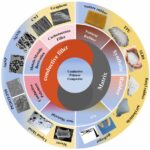 The construction industry, notorious for its hefty carbon footprint, is on the brink of a green revolution, thanks to the innovation of eco-voxels. Developed by a team at Georgia Tech, these cutting-edge building blocks are paving the way for a more sustainable future, both on our planet and in space.
The construction industry, notorious for its hefty carbon footprint, is on the brink of a green revolution, thanks to the innovation of eco-voxels. Developed by a team at Georgia Tech, these cutting-edge building blocks are paving the way for a more sustainable future, both on our planet and in space.
Eco-voxels, which were introduced in the scientific journal Matter, represent a new breed of modular construction units. They promise to slash carbon emissions by up to 40% compared to the usual suspects—cement, steel, and concrete—that dominate the industry. As Christos Athanasiou, an assistant professor at the Daniel Guggenheim School of Aerospace Engineering, puts it, “We created sustainable structures using these eco-friendly building blocks, combining our knowledge of structural mechanics and mechanical design with industry-relevant manufacturing practices and environmental assessments.”
So, what exactly are these eco-voxels? They’re made from polytrimethylene terephthalate (PTT) and fortified with recycled carbon fibers sourced from aerospace waste. This unique mix makes them easy to assemble into strong, adaptable structures without generating waste—a crucial step towards eco-friendly construction.
The beauty of eco-voxels is their versatility. On Earth, they offer a quick and sustainable solution to the housing affordability crisis, especially in disaster-prone areas. In space, they shine even brighter. Traditional building methods just don’t cut it on Mars or the Moon, but eco-voxels, with their lightweight and easy-to-assemble nature, are perfect for creating habitats in these challenging environments. Athanasiou notes, “The ability to build these structures quickly is a significant advantage for space construction. In space, we need lightweight units made from locally sourced materials.”
Eco-voxels aren’t just about reducing environmental impact. They also offer practical solutions for emergency shelters when disasters strike. With their low carbon footprint and high performance, they stand out as a promising alternative to methods like 3D-printed concrete and cross-laminated timber.
In short, eco-voxels are reshaping how we think about construction, offering a sustainable and affordable path forward both here on Earth and in the vastness of space.








